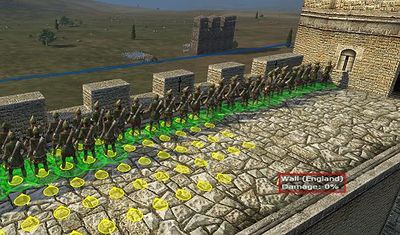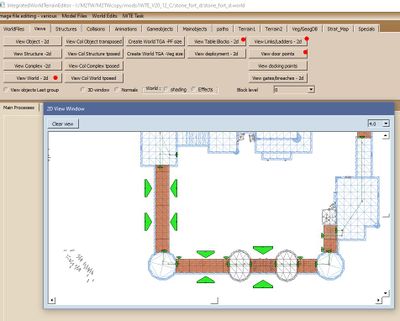Difference between revisions of "On-wall deployment - M2TW"
(Created page with "{{M2TW Modding Logo}} In siege battles in Medieval II: Total War infantry can stand and fight on the flat wall surfaces around the perimeter of most settlements, forts an...") |
(→View Existing Deployment) |
||
| Line 14: | Line 14: | ||
[[File:On wall deployment M2TW.jpg|400px|View of deployment and links in IWTE]] | [[File:On wall deployment M2TW.jpg|400px|View of deployment and links in IWTE]] | ||
| + | |||
| + | Note: in that screen, the on-wall deployment is referred to as 'table blocks' (from the initial decoding of the file structure!) - the 'deployment' mentioned there is the Deployment Outline which limits the area the defending troops can initially deploy into. | ||
| + | |||
| + | ==Requirements for a Functioning Deployment Block== | ||
| + | For a new block to be added in IWTE the objects must share a flat horizontal surface within a very limited tolerance of minor height variation. | ||
| + | |||
| + | For the block to be useable in-game the objects should have collision volumes, and the block must have at least one 'door point' with a 'link/ladder' connection, either directly to a 'ground level door' or to another block that has such a connection. | ||
| + | |||
| + | For the AI to favour standing on an on-wall block that has a reachable wall within it, there must be door points either side of the breach, so it can retreat to either side if the wall is attacked with artillery. | ||
| + | |||
| + | The attacking AI will only attack one breachable element per block, e.g. if you have three wall breaches under the same block it will only attack/climb one regardless of how much artillery, or how many ladders it has. If you have a gate and wall elements under the same block it will only attempt to use the gate and not attack the walls. | ||
| + | |||
| + | ==Adding a Deplpoyment Block with IWTE== | ||
Revision as of 01:01, 17 March 2021
In siege battles in Medieval II: Total War infantry can stand and fight on the flat wall surfaces around the perimeter of most settlements, forts and castles. This article explains the mechanics of this process and how to add your own on-wall deployment blocks with IWTE.
To date only infantry units can be deployed on walls, mods that purport to have artillery on walls have achieved the effect by having wide blocks of terrain hidden under a superficial 'wall' structure.
View Existing Deployment
In game when you deploy or give move orders to troops on a wall you will see small yellow symbols which represent where each soldier will stand and the direction they will stand.
To view the on wall deployment of an existing settlement in IWTE, Read 3 Binary Files to load the .world, .worldcollision and .animinstances go to the Views tab, and select View World - 2d, View Table Blocks - 2d, View Links/Ladders - 2d and View door points
Note: in that screen, the on-wall deployment is referred to as 'table blocks' (from the initial decoding of the file structure!) - the 'deployment' mentioned there is the Deployment Outline which limits the area the defending troops can initially deploy into.
Requirements for a Functioning Deployment Block
For a new block to be added in IWTE the objects must share a flat horizontal surface within a very limited tolerance of minor height variation.
For the block to be useable in-game the objects should have collision volumes, and the block must have at least one 'door point' with a 'link/ladder' connection, either directly to a 'ground level door' or to another block that has such a connection.
For the AI to favour standing on an on-wall block that has a reachable wall within it, there must be door points either side of the breach, so it can retreat to either side if the wall is attacked with artillery.
The attacking AI will only attack one breachable element per block, e.g. if you have three wall breaches under the same block it will only attack/climb one regardless of how much artillery, or how many ladders it has. If you have a gate and wall elements under the same block it will only attempt to use the gate and not attack the walls.


